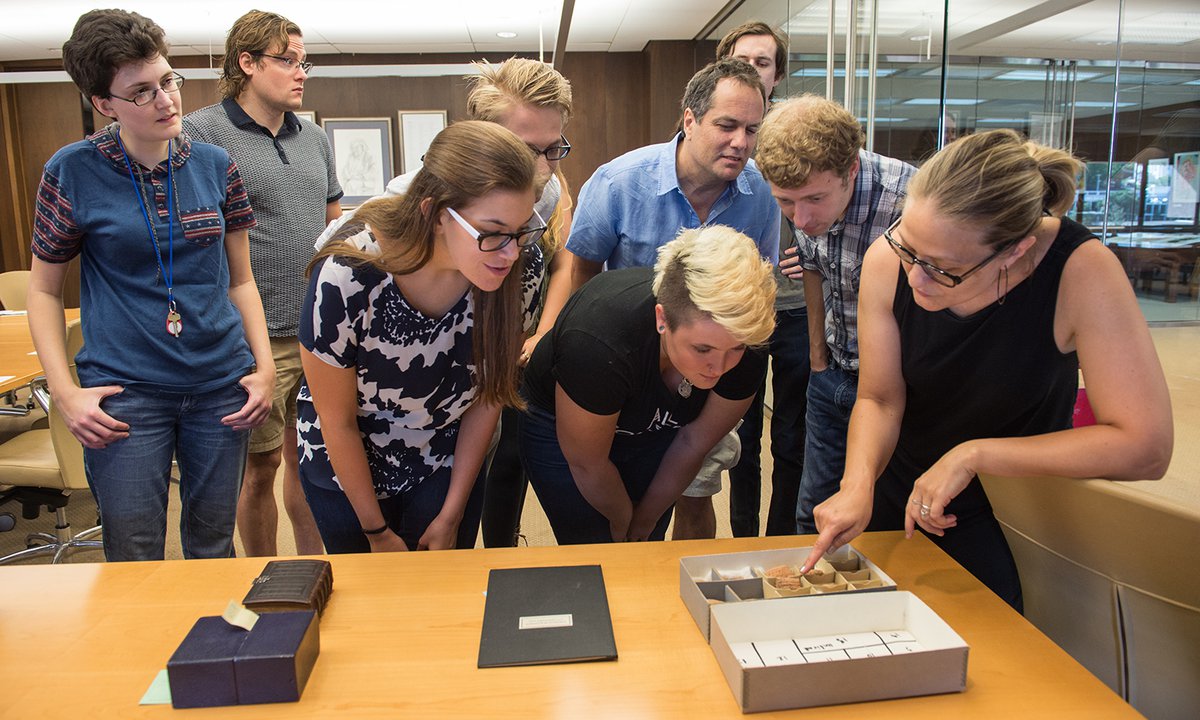Special Collections Research Center
Page featured image content

Page main body content
Welcome to the Special Collections Research Center (SCRC)! Located on the 6th floor of Bird Library, SCRC advances scholarship and learning by collecting, preserving and providing access to primary source materials.
SCRC’s collections span time and format, from cuneiform tablets to digital media, and document the history of Syracuse University and our global society through rare and unique printed materials, photographs, artworks, audio and moving image recordings, University records and more.
Access is free and open to the University community and greater public in our Reading Room.
Come explore our collections and visit us.
SCRC Overview
Vision
SCRC is a vibrant research and learning environment for Syracuse University students, faculty, and the wider community. We provide access to our world-renowned rare and archival collections and expert guidance in their use to facilitate personal discovery and the creation of new knowledge.
Mission
SCRC collects, preserves, and provides access to materials that document the history of Syracuse University and our global society, including rare printed materials, original manuscripts, photographs, artworks, audio and moving image recordings, University records and more.
SCRC staff is dedicated to encouraging and facilitating the use of the collections by:
- Engaging students, faculty and the community with our collections through public programs, fellowships, exhibitions, digital initiatives and publications.
- Supporting innovative undergraduate and graduate learning by fostering new ideas about the role of special collections in the University's curriculum.
- Prolonging the life of the University's rare and archival holdings for generations of students, researchers and community members by implementing ongoing preservation measures.
- Providing a variety of opportunities to access and explore these collections.
- Implementing a reparative framework for collection development, description and primary source instruction that fosters representation of marginalized voices to better serve and reflect our diverse campus and research community.
SCRC was formerly known as the George Arents Research Library and started as part of the University’s fledgling library in 1870. The first major acquisition of the special collections in 1897 was made possible by a generous donation with the purchase of the library of Leopold von Ranke, the founder of modern historical research technique. Since then, SCRC has continued to expand its collections to represent a plethora of topics and research interests. In 2016, University Archives and the Belfer Audio Archive and Preservation Laboratory merged with SCRC, creating a unified repository and research center for all library collections.
The collections contain some content that may be harmful or difficult to view. These materials are preserved for their historic and research value.
Collection materials may be harmful because:
- they may contain language and images that are racist, homophobic, sexist, ableist or otherwise derogatory and insensitive;
- they demonstrate bias and exclusion in institutional collecting; and/or
- they reflect and reinforce societal power structures.
Archivists, curators and librarians choose what language to use when describing materials. Finding aids may therefore contain harmful language because:
- some descriptions were written many years ago, using language that was accepted at the time;
- archivists often use standardized search terms, such as the Library of Congress Subject Headings, some of which may be outdated or insensitive; and/or
- archivists also often re-use language provided by creators or former owners of the archival materials to provide context, but which also reflect biases and prejudices.
While the SCRC holds these materials as part of the historic record, staff are also actively seeking to balance the preservation of this history with sensitivity to how these materials are described for researchers. SCRC staff are committed to a reparative archival framework to do justice to those whose humanity has been harmed, silenced, ignored or disenfranchised within the historical record. This ongoing work includes identifying harmful items within the collections we hold, assessing and updating descriptions that are harmful, and establishing standards and policies to prevent future harmful language in staff-generated descriptions. We are working to:
- inform users about the presence and origin of harmful content when we find or are made aware of such materials;
- revise descriptions and standardized descriptive terms, supplement description with more respectful terms, or use preferred names for people represented in our collections;
- research the problem, listen to users and communities, and share our findings with each other and colleagues across the archival field;
- evaluate existing processes for exclusionary practices or institutional bias that prioritize one culture and/or group over another; and
- make a commitment to diversity, equity, inclusion and accessibility.
Due to the large volume of collection materials in SCRC, the reparative work of our staff is ongoing, and we often need to rely on our patrons and researchers to assist with these efforts.
You can help us in our reparative work by reporting potentially harmful language in our finding aids or potentially harmful collection material not already identified in our finding aids. Please email us at scrc@syr.edu or speak to our Reading Room staff. SCRC will determine whether we will change or remove terms from archival descriptions. We will weigh potential harm against considerations such as input from affected communities, accurate preservation of the historical record, professional best practices and allocation of staff resources.
